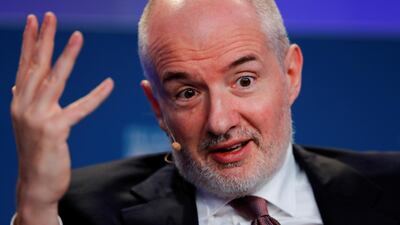Real gross domestic product in the US is expected to recover to last year’s level by the end of 2021 while inflation will rise slowly, the head of the Pacific Investment Management Company said.
This will mean the Federal Reserve will probably keep interest rates low, Emmanuel Roman told a Bloomberg web event on Tuesday evening.
A high degree of uncertainty still exists in the US economy, with several unknowns in sectors such as retail, leisure and oil and gas and leisure, he said.
As the Covid-19 infection rate increases in most states, consumer behaviour remains fickle, meaning the uptake of air travel or use of movie theatres remain hard to predict.
“When I think about the next 12 months, the error rate has to be much higher, in terms of predictions,” Mr Roman said.
After unemployment hit a record low last year, the US economy ended its longest-ever expansionary run this year as the Covid-19 pandemic forced the government to close borders and shut all-but essential businesses to curb the spread of the virus.
The US is the country hardest hit by the pandemic, with more than 2.3 million infections and more than 120,000 deaths, according to Johns Hopkins University.
The Trump administration poured about $3 trillion (Dh11tn) into the economy after unemployment claims peaked at about 37 million last month, the highest level in decades.
However, as states reopen and economic momentum picks up, the rate of infections is also soaring, stoking fears of another lockdown.
The US Federal Reserve has also unveiled monetary easing measures such as cutting interest rates to near zero and buying bonds and securities to bring stability to financial markets.
The S&P 500 Index and Dow Jones Industrial Average, which both fell into bear market territory in March, have largely recovered their losses.
Pimco economists project that inflation will make a slow recovery to 2.3 and 2.4 per cent over the next couple of years, Mr Roman said.
“The days of inflation that we grew up with are gone. It [inflation] is something we have to look at but we don’t think the Fed is going to raise the rates for a very long time,” he said.
The Fed “learnt the lessons [of] hiking interest rates too fast” in 2005, 2008 and 2018, he said.
Pimco, which has $1.8tn worth of assets under management, is raising at least $6 billion to take advantage of distressed credit and corporate debt opportunities.
It also looks to return as an originator of collateralised loan obligations for the first time since 2006, and expects to charge higher interest rates and impose stricter underwriting standards than in pre-pandemic issues, Bloomberg reported.
“If you look at the US cycles, distress is a long cycle and the ability to [allocate] capital to restructuring ... is actually the opportunity to deliver outsized returns," Mr Roman said.
"It is something we are focusing on and there are opportunities to buy cheap businesses and credit. [With] the ability to put them in the correct fund structure and correct liquidity, I think the industry will deliver outsize returns.”
He stressed that Pimco is bullish on the US housing sector and said the mortgage market provides steady opportunities.
“We think housing in the US doesn’t have enough supply and the prices, give or take, are stable, given what we know,” he said.


